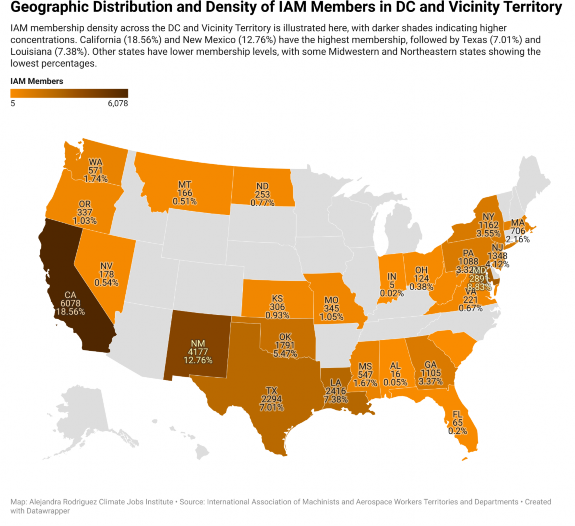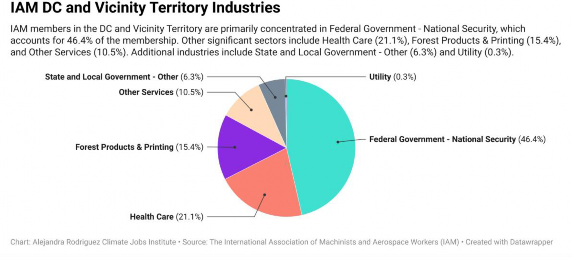< Previous | Contents | Next >
The IAM’s DC and Vicinity Territory represents a diverse set of employees within the federal government. This territory has members in 28 states through the National Federation of Federal Employees (NFFE), an IAM-affiliated national union that represents 110,000 federal workers.
NFFE members include 50,000 civilian military employees, all passport processing workers, 10,000 healthcare professionals in the Veterans Administration, 10,000 Forest Service workers caring for federal lands, and 10,000 Wildland Firefighters.189 NFFE members can be found in 35 additional government agencies including the Government Service Administration. Outside the NFFE and the DC & Vicinity Territory, over 36,000 additional IAM members work for federal contractors under the Service Contract Act (SCA). SCA contractors perform a range of jobs like mechanics, maintenance, operations, and training.
![]()
184 De La Cruz, Rene Ray, “Major High-Speed Rail Bill Gains Support from Congressional Lawmakers.”
186 Nevada Department of Transportation, “Brightline West High Speed Rail Project.”
187 Barnard, Michael, “Most Rail Is Already Electric And All Will Be Even In North America.”
188 Nunno, Richard, “Electrification of U.S. Railways: Pie in the Sky, or Realistic Goal?”


IAM members in the federal government face a number of challenges due to climate change. One of the most dramatic examples are wildland firefighters, where the increased frequency and intensity of forest fires are added stressors to a dangerous job. Climate change is causing hotter, drier conditions that have increased the frequency and severity of wildfires over the past 30 years. In that time, fires have doubled, with 8 million acres of forest burning annually in the United States.190 In Canada (where NFFE does not represent members), an average of over 6 million acres of forest have burned annually since 1990.191
But these averages do not truly capture the growth of wildfires in recent years. While the United States had a relatively tame wildfire season in 2023, Canada had “the most destructive ever recorded” according to government statistics, with over 40 million acres burned.192 Firefighters not only face high risks of injury and death dealing with these fires, but they also are at high risk for mental health and respiratory problems.193 Additionally, firefighting conditions are a known cause of cancer.194
On top of the health risks, low pay is leading to high turnover and low application rates to firefighting positions.195 Over the last 3 years, the Forest Service has seen a 45% attrition rate for permanent employees in the fire service. An understaffed and inexperienced workforce has been left to contend with more intense and fast-moving blazes.196 Early in his presidency, President Biden authorized wage increases of up to $20,000 a year for wildland firefighters. But these raises have not been made permanent and are at the whim of congressional action every year.197 Climate-conscious policy making is critical to the health of federal workers and the future of their jobs.
Additionally, many SCA workers are employed by Department of Defense (DoD) contractors and work on military bases alongside the NFFE-represented civilian military workers. Military bases face particularly high climate risks, as over one-third are near coastlines and are vulnerable to sea level rise and extreme weather events.198 When climate disasters strike military installations, they extract a high cost. In 2018, hundreds of IAM members at Tyndall Air Force Base (AFB) witnessed Hurricane Michael destroy 500 buildings and cause $4.7 billion in damages.199
![]()
190 Congressional Budget Office, “Wildfires.”
191 Government of Canada, “Forest Fires.”
192 Government of Canada, “Canada’s Record-Breaking Wildfires in 2023.”
193 Congressional Budget Office, “Wildfires.”
194 Demers et al., “Carcinogenicity of Occupational Exposure as a Firefighter.”
196 Streep, “America Needs Wildland Firefighters More Than Ever, but Attrition Is At Record Levels.”
198 Congressional Budget Office, “Wildfires.”
199 Department of Defense, “Climate Adaptation Plan 2022 Progress Report.”
Despite these challenges, climate action also presents many opportunities for growth in the territory and in the federal sector more broadly. As the federal government decarbonizes its operations, IAM members stand to benefit from new work opportunities and safer workplaces. The Department of Defence (DoD) climate action plan includes steps to move towards 100% carbon pollution-free electricity, 100% zero-emission vehicle fleet acquisitions, and net-zero emissions buildings, campuses, and installations.200 To meet these goals, the DoD is investing in massive projects with serious price tags. In 2024, the military has requested $5.1 billion for “enhancing combat capability and mitigating climate risk.” Of those funds, $3.7 billion is for installation, resilience and adaptation.201
As a pilot, the Army has constructed a net-zero base at Fort Hunter Liggett in CA, where the IAM represents members. At Fort Hunter Liggett, construction of a micro grid, a solar power plant, and battery storage will produce more energy than the base uses.202 At Edwards AFB, the largest DoD public-private collaboration to date employed union labor to build 2 million solar panels that generate 1,300 MW of power.203 Many of the projects linked to this investment in climate adaptation and mitigation for the military will be completed by IAM-represented military contractors. Additionally, NFFE-represented members are in civilian military positions that administer contracts.
NFFE members in the Government Services Administration (GSA) are responsible for federal buildings. The federal government owns and operates thousands of buildings in every corner of the country, and it has an ambitious goal “to retrofit 6% of the federal portfolio each year between 2022 and 2030… to reach 50% reduction by 2030.”204 Projects in federal buildings, including retrofits and decarbonization measures, are managed by union members in the GSA. Any legislation that would increase the pace of decarbonization in federal buildings would increase work opportunities for union members at the GSA, while also improving working conditions for IAM members who spend hours every day in government buildings.
Bargaining is another opportunity to ensure that IAM members are protected from the changing climate. In some contracts, the IAM has negotiated that SCA workers receive pay for days off in the event of a base closure due to extreme weather. Additionally, many SCA workers work outside and have bargained for the right to wear shorts as part of their uniforms.205 Members have also benefited from the construction of shade structures for airplanes, reducing their exposure during heat waves and other extreme weather.
![]()
200 Department of Defense, “Sustainability Plan.”
201 Congressional Research Service, “Climate Change and Adaptation: Department of Defense.”
202 Congressional Research Service.
204 GSA, “GBAC Federal Building Decarbonization Task Group.”